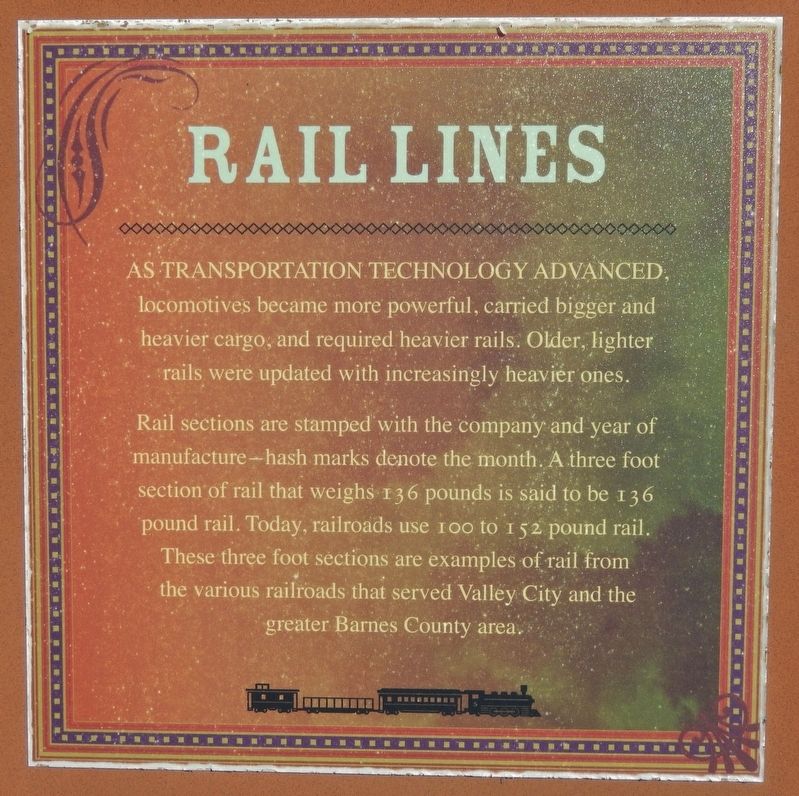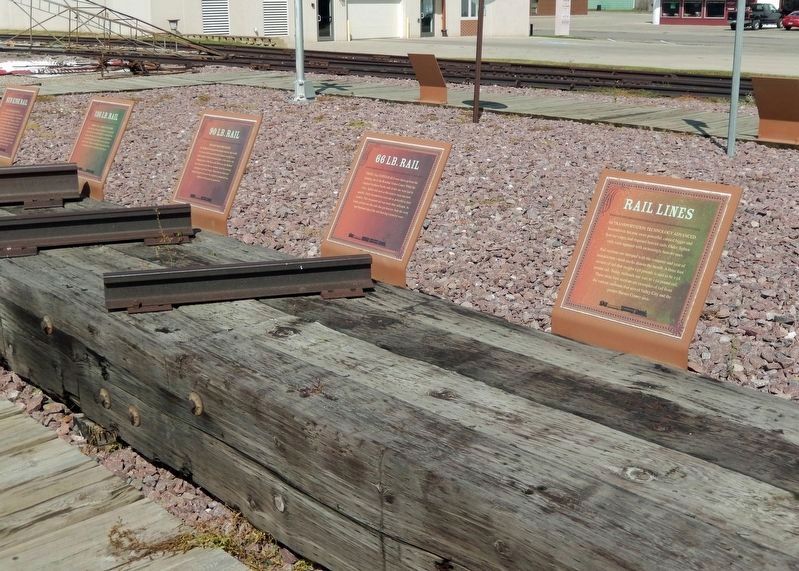Valley City in Barnes County, North Dakota — The American Midwest (Upper Plains)
Rail Lines
As transportation technology advanced, locomotives became more powerful, carried bigger and heavier cargo, and required heavier rails. Older, lighter rails were updated with increasingly heavier ones.
Rail sections are stamped with the company and year of manufacture — hash marks denote the month. A three foot section of rail that weighs 136 pounds is said to be a 136 pound rail. Today, railroads use 100 to 152 pound rail. These three foot sections are examples of rail from the various railroads that served Valley City and the greater Barnes County area.
Topics. This historical marker is listed in this topic list: Railroads & Streetcars.
Location. 46° 55.418′ N, 98° 0.365′ W. Marker is in Valley City, North Dakota, in Barnes County. Marker can be reached from West Main Street (Business U.S. 10/50) 0.1 miles west of Central Avenue North (County Highway 21), on the right when traveling west. The marker is located on the Rosebud Visitor Center grounds. Touch for map. Marker is at or near this postal address: 250 West Main Street, Valley City ND 58072, United States of America. Touch for directions.
Other nearby markers. At least 8 other markers are within walking distance of this marker. Wood Beam (here, next to this marker); 66 Lb. Rail (here, next to this marker); 90 Lb. Rail (here, next to this marker); Valley City Street & Interurban Railroad (here, next to this marker); 136 Lb. Rail (here, next to this marker); Sun Kink Rail (here, next to this marker); Building the Railroad (a few steps from this marker); Rosebud Visitor Center Along the Byway (within shouting distance of this marker). Touch for a list and map of all markers in Valley City.
Related markers. Click here for a list of markers that are related to this marker. Rosebud Visitor Center Railroad History Exhibit
Also see . . . Railway Track (Wikipedia). Excerpt:
Early tracks were constructed with wooden or cast-iron rails; since the 1870s, rails have almost universally been made from steel. Modern track typically uses hot-rolled steel with a profile of an asymmetrical rounded I-beam. Unlike some other uses of iron and steel, railway rails are subject to very high stresses and have to be made of very high-quality steel alloy. It took many decades to improve the quality of the materials, including the change from iron to steel. The stronger the rails and the rest of the trackwork, the heavier and faster the trains the track can carry. Rail is graded by its linear density, that is, its mass over a standard length. Heavier rail can support greater axle loads and higher train speeds without sustaining damage than lighter rail, but at a greater cost. In North America and the United Kingdom, rail is graded in pounds per yard, so 130-pound rail would weigh 130 lb/yd. The usual range is 115 to 141 lb/yd. The heaviest rail mass-produced was 155 pounds per yard (77 kg/m) and was rolled for the Pennsylvania Railroad.(Submitted on March 9, 2024, by Cosmos Mariner of Cape Canaveral, Florida.)
Credits. This page was last revised on March 11, 2024. It was originally submitted on March 7, 2024, by Cosmos Mariner of Cape Canaveral, Florida. This page has been viewed 41 times since then. Photos: 1, 2. submitted on March 9, 2024, by Cosmos Mariner of Cape Canaveral, Florida.

